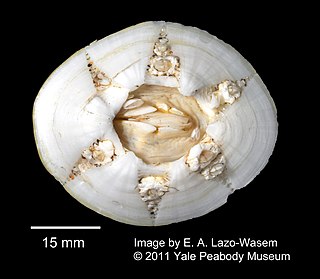
Thoracica is an infraclass of crustaceans which contains the most familiar species of barnacles found on rocky coasts, such as Semibalanus balanoides and Chthamalus stellatus. They have six well-developed limbs, and may be either stalked or sessile. The carapace is heavily calcified. The group includes free-living and commensal species.

Thecostraca is a class of marine invertebrates containing over 2,200 described species. Many species have planktonic larvae which become sessile or parasitic as adults.

The Balanidae comprise a family of barnacles of the order Balanomorpha. As a result of research published in 2021 by Chan et al., the members of the family Archaeobalanidae were merged with this family.

Sessilia is an unranked clade of barnacles, comprising the barnacles without stalks, or acorn barnacles. They form a monophyletic group and are probably derived from stalked or goose barnacles. Sessilia is divided into two orders. The Verrucomorpha contain two families, Verrucidae and Neoverrucidae, and the remaining 14 families are in the order Balanomorpha.

Whale barnacles are species of acorn barnacle that belong to the family Coronulidae. They typically attach to baleen whales, and sometimes settle on toothed whales. The whale barnacles diverged from the turtle barnacles about three million years ago.

Megabalanus is a genus of barnacles in the family Balanidae. Members of the genus grow to 7 cm (2.8 in) in length and inhabit the lower intertidal zone.

Megabalanus tintinnabulum is a species of large barnacle in the family Balanidae. It is the type species of the genus. The specific name comes from the Latin tintinnabulum meaning a handbell and probably refers to the fact that small groups of barnacles resemble clusters of miniature bells.

Chelonibia is a genus of acorn barnacles in the family Chelonibiidae of the subphylum Crustacea. Its members are epizootic and live attached to manatees, turtles, marine molluscs, crabs and horseshoe crabs in all tropical and subtropical oceans. In a few instances, they have been found on sea snakes, alligators and inanimate substrates, but they are not found in the typical habitats of barnacles – on rocks, docks or boats.

Chelonibiidae is a family of turtle barnacles in the order Balanomorpha. There are at least three genera and about eight described species in Chelonibiidae.

The Chthamaloidea are a subdivision of Balanomorpha proposed by Newman and Ross to include barnacles with shell wall composed of rostrum, carina, and one to three pairs of latera, rarely supplemented with one or more whorls of basal imbricating plates. The rostrolatus enters the sheath, but rarely fuses with the rostrum, as in the three higher superfamilies. Shell plates are simple in construction, solid, and incorporate organic chitin between carbonate layers. Opercular plates are deeply interlocked, and in some genera, may become concrescent with age. Soft part morphology includes concave labrum without notch in the central part. Cirrus III more resembles Cirrus IV than II, or may be intermediate in structure. Caudal appendages present in some species.
The Catophragmidae are a family of barnacles in the superfamily Chthamaloidea with eight shell wall plates, surrounded by several whorls of imbricating plates. The basis is membranous.

Catomerus is a monotypic genus of intertidal/shallow water acorn barnacle that is found in warm temperate waters of Australia. The genus and species is very easily identified by whorls of small plates surrounding the base of the primary shell wall; no other shoreline barnacle species in the Southern Hemisphere has that feature. This species is considered to be a relic, as these plates are found only in primitive living lineages of acorn barnacles or in older fossil species. The fact that this is an intertidal species is unusual, because living primitive relic species are often found in more isolated habitats such as deep ocean basins and abyssal hydrothermal vents.

Amphibalanus is a genus of barnacle of the family Balanidae that includes species formerly assigned to Balanus. It contains the following species:

The clade Multicrustacea constitutes the largest superclass of crustaceans, containing approximately four-fifths of all described crustacean species, including crabs, lobsters, crayfish, shrimp, krill, prawns, woodlice, barnacles, copepods, amphipods, mantis shrimp and others. The largest branch of multicrustacea is the class Malacostraca.

Tetraclitidae is a family of sessile barnacles in the order Balanomorpha. There are about 10 genera and more than 50 described species in Tetraclitidae.

Scalpellidae is a family of acorn barnacles in the order Scalpellomorpha. There are about 25 genera and 220 described species in Scalpellidae.

Pyrgomatidae is a family of barnacles belonging to the order Balanomorpha.

Calanticomorpha is an order of acorn barnacles in the class Thecostraca. There are 3 families and more than 90 described species in Calanticomorpha.

Verrucomorpha is an order of asymmetrical sessile barnacles in the class Thecostraca. They are typically found in deeper and deep-sea habitats. There are 2 families and more than 100 described species in Verrucomorpha.
















